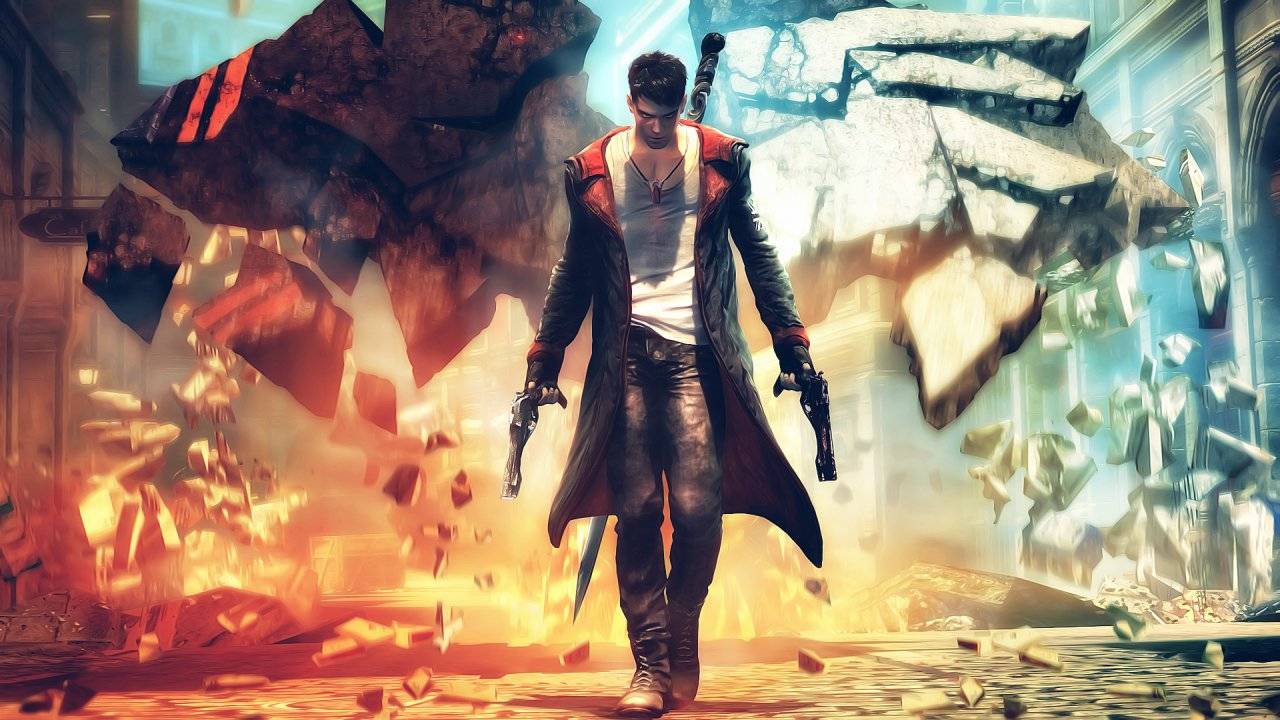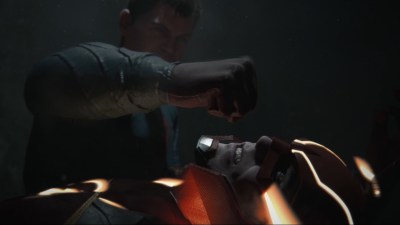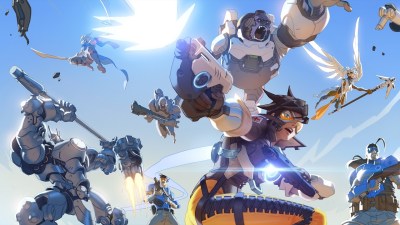It feels good to hold Ebony and Ivory in your hands again.
With DmC: Devil May Cry being a reboot at the hands of Enslaved and Heavenly Sword creators Ninja Theory, the scenery may have changed - but this is still the same demon slaying you’ve come to know and love: from the fast-paced combat, over-the-top combos, cheesy puns, to the Devil Slayer Dante himself, just with shorter, darker hair.
In the beginning, at least.
Being a reboot of such an acclaimed game series, there was always going to be something of a degree of expectation weighing on the shoulders of Ninja Theory. The main purpose of any reboot is to breathe a breath of fresh air into a stagnant series, and Ninja Theory clearly stretched their remit as far as they could take it when Capcom handed them the reins to Devil May Cry. For the most part, they’ve been successful; but in the process they’ve also created one of the most divisive games of recent years.
When Ninja Theory initially revealed the new-look Dante, scorn was poured on his design by fans for moving so far away from what made him such an iconic character in the first place. Gone was the silver hair and in came a short black mop; out went the clean-cut fashion sense and its place we were introduced to a more rough-and-ready approach, a force of nature adorned in a grubby vest and worn black jeans. Dante still sports his familiar sword and gun combo as well as his iconic trenchcoat, but it’s fair to say that on first glance he’s all but unrecognizable - a loose homage to the original, rather than being a clear reinvention of him.
But while the new-look Dante may not have gone down well with many fans, he’s still likable enough, with plenty of cocksure attitude and a quip for every encounter. You warm to him over time, even if you never truly grow to love him. If you can look past Dante not being exactly the way you remember him to be, or have never played a Devil May Cry game before this one, you are getting the full, new and improved, DmC experience when it comes to gameplay, which remains fairly close to what fans will remember. The game also retains its grading system that starts from the traditional D to A, than jumps to S, SS, and SSS for the longer you manage to maintain and diversify your combo.
DmC: Devil May Cry wants you here for the action, and it gets that point across very quickly. You’re thrust into battle within the first few minutes of the game, and are given a wide variety of combos to play with right from the get-go. However while doing this; the game still manages to weave in an intricate and intriguing story, albeit one filled with well-worn tropes and deus ex machinas. You do have the choice to ignore it all together, as it won’t interfere with your demon hacking-and-slashing, but you just might not want to. It’s window-dressing, sure, but there’s some enjoyment to be gleaned from all the silliness.
The game clocks in at around 8 hours. While the game is relatively shorter than previous Devil May Cry installments, the shorter length makes for a compact and fast pacing that is just long enough to hold your attention, and with the level of replayability this game holds, trying to get higher scores or for the sheer enjoyment of demon slaying, you’ll more than likely spend more than 8 hours in this game.
The story is there to pay attention to, but it’s not being constantly screamed in your face or removing you from the pacing of the game with the exception of one or two missions where you’re forced to walk, simply to serve the requirements of the narrative. Overall, DmC is effective as an origin story, reintroducing you to notable characters of the series within the realms of this brand new universe, utilizing a potent balance of new and old elements of the previous Devil May Cry installments. The ending is a bit underwhelming in comparison to the rest of the story, but as they say, it’s all about the journey, not the destination.
DmC retains its fast-paced hack-and-slash combat, split into an arcade-like mission structure, while bringing new elements to the table such as various different weapons with their own unique fighting styles and the ability to interchange between these weapons mid-combo with the press of a button, allowing for an almost unlimited number of combo variations.
There’s even a practice mode where you can test out some combo ideas on a ragdoll enemy that doesn’t hit back. You may discover that in some cases, you can string together an infinitely long combo, staying in the air indefinitely, which can either be extremely overpowered or satisfying to pull off, depending on how you’d like to look at it.
Weapons and combos can be upgraded by spending the red orbs dropped by enemies on death, and you may find yourself grinding some levels to rack up orbs in order to artifically progress Dante’s skills to make things a bit easier on you. You have access to both Demon and Angel abilities, allowing you to diversify your fighting style and interact with the environment differently. While you still retain Dante’s trademark dual pistols, Ebony and Ivory, and his Demon blade, Rebellion, you also have access to specific Angel and Demon weapons. There’s Arbiter, a slow but powerful Demon ax, and Osiris, a fast-moving, combo-heavy Angel scythe. And those are just the first two of the bunch.
Certain enemies are more susceptible to Angel and/ or Demon weapons, and these weapons also allow you to traverse through certain areas via blue or red indicators. You’ll never find yourself ignoring a specific weapon entirely in favor of another, because virtually every weapon works best on a specific enemy, and adds its own effects to your combos.
The need to switch between your various weapons and movesets mid-battle forces you to think tactically, and it’s incredibly satisfying to chain together an insanely long combo that ends with entire hordes of demons being cleared from the screen in one swift, fluid ballet of death and destruction.
DmC features a fast amount of enemy types each with their own unique strengths and weaknesses. However you may find yourself enjoying some of the earlier introduced enemies the most. Later on, the game struggles to keep things fresh and as a result you can’t help but feel as though Ninja Theory started to run out of ideas. As a result, the quality starts to dip a little and it’s likely that your interest may have started to wane by the time you reach the credits - lending a sense of relief to the end of the final battle which threatens to eclipse your satisfaction.
The harder enemy types that appear later on in the game can slow the pacing of the excellent fast-moving combat at times, and merely gets worse the further you progress into the game. While it is satisfying to take out a few powerful enemies with the right combination of timing and finding out which moves are most effective, it is much more fun to senselessly pummel dozens of weaker enemies mindlessly, experimenting with your own combos, rather than being forced to take out smaller amounts of stronger enemies a certain way.
The game compensates for this often enough by still throwing hordes of lesser enemies at you from time to time, that are easy enough to chain together your moves, but hard enough to where you actually have to pay attention to their movements to avoid getting yourself killed.
The boss battles are where the combat shines the most however. I typically don’t care for boss battles in a game where the emphasis is on fighting multiple enemies simultaneously, but in this case, it’s just as, if not more fun than slicing through the hordes of fodder. They aren’t too hard or too easy; you typically figure out their weakness in the first time you encounter them, and it’s quite satisfying to exploit that weakness to get the upper hand, using your mastered abilities to tear them a new one.
Each of these set-piece encounters are just as satisfying to play a second or third time. Once you’ve beaten one boss, you may find yourself defeating them flawlessly in a matter of seconds in a second playthrough, something which really makes you feel as though you’re a veteran demon hunter and could see you adopting this new Dante’s cocksure swagger.
Some of these bosses have their pros and cons however. On the one hand, they each have their own unique roles: from being a propaganda news reporter, to a strip club owner; they each fit comfortably into their own niches within Mundus’ hierarchy. They can be, however, a bit over-the-top personality wise, Mundus himself included, making you begin to take the game a little less seriously when they’re on screen and detracting a little from the atmosphere.
DmC: Devil May Cry may not be the reboot fans of the franchise wanted, but it’s a damn good game on its own merits. The fast-paced action and addictive chaining together of combos will keep you coming back multiple times after completing your first playthrough. The story is strong enough to allow you to become connected with the game’s characters, and you may find Dante a bit more likeable once the plot reaches its final act.
Any fan of the series, or someone looking for a fun game to play, should indulge in the demon-slaying madness that is DmC: Devil May Cry. With its ridiculous combat, and an equally ridiculous Dante slicing and dicing his way through the horrendous world of Limbo, you’re in for one hell of a ride.



